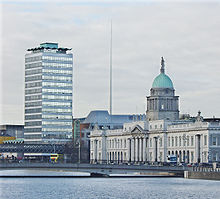Irish economy

Liberty Hall, Spire of Dublin
|
|
| Currency | 1 Euro = 100-cent(s)= 1.17$ |
|---|---|
| Calendar year | |
|
Trade organisations
|
EU, WTO and OECD |
| Statistics | |
| GDP |
|
| GDP rank | 41st (nominal, 2016) |
|
GDP growth
|
|
|
GDP per capita
|
|
|
GDP by sector
|
Services (70.4%), industry (28%), agriculture (1.6%) (2013 est.) |
|
|
|
|
Population below poverty line
|
8.0% (consistent poverty in 2014) Poverty line in 2015: €10,926/year or ~$950/month |
| 30.0 (2014) | |
|
Labour force
|
|
|
Labour force by occupation
|
services (78%), industry (19%), agriculture (5%) (2011 est.) |
| Unemployment |
|
|
Average gross salary
|
€3,133 / $3,592, monthly (2017-Q1) |
| €2,479 / $2,842, monthly (2017-Q1) | |
|
Main industries
|
|
|
|
|
| External | |
| Exports |
|
|
Export goods
|
Machinery and equipment, computers, chemicals, medical devices, pharmaceuticals; foodstuffs, animal products |
|
Main export partners
|
|
| Imports |
|
|
Import goods
|
Data processing equipment, other machinery and equipment, chemicals, petroleum and petroleum products, textiles, clothing |
|
Main import partners
|
|
|
|
|
|
Gross external debt
|
|
|
|
|
| Public finances | |
|
|
|
| Revenues |
|
| Expenses |
|
| Economic aid | Donor of ODA: €651 million Recipient of agricultural aid: $895 million (2010) |
|
|
|
Foreign reserves
|
|
The economy of Ireland is a modern knowledge economy, focusing on services and high-tech industries and dependent on trade, industry and investment. In terms of GDP per capita, Ireland is ranked as one of the wealthiest countries in the OECD and the EU-27 at 5th in the OECD-28 rankings as of 2008. In terms of GNP per capita, Ireland ranks only slightly above the OECD average, despite significant growth in recent years, at 10th in the OECD-28 rankings. GDP (national output) is significantly greater than GNP (national income) due to the repatriation of profits and royalty payments by multinational firms based in Ireland.
A 2005 study by The Economist found Ireland to have the best quality of life in the world. The 1995 to 2007 period of very high economic growth, with a record of posting the highest growth rates in Europe, led many to call the country the Celtic Tiger. One of the keys to this economic growth was a low corporation tax, currently at 12.5% standard rate.
The Irish financial crisis severely affected the economy, compounding domestic economic problems related to the collapse of the Irish property bubble. After 24 years of continuous growth at an annual level during 1984–2007, Ireland first experienced a short technical recession from Q2-Q3 2007, followed by a long 2-year recession from Q1 2008 – Q4 2009. In March 2008, Ireland had the highest level of household debt relative to disposable income in the developed world at 190%, causing a further slow down in private consumption, and thus also being one of the reasons for the long lasting recession. The hard economic climate was reported in April 2010, even to have led to a resumed emigration.
After a year with stagnant economic activity in 2010, Irish real GDP rose by 2.2% in 2011 and 0.2% in 2012, which was mainly driven by strong improvements in the export sector – while private consumption remained subdued. The economic challenges continued, however, as the prolonged European sovereign-debt crisis caused a new Irish recession starting in Q3 2012, which was still ongoing as of Q2 2013. In May 2013 the European Commission's economic forecast for Ireland predicted its growth rates would return to a positive 1.1% in 2013 and 2.2% in 2014. The Irish economy grew by 4.8% in 2014.
...
Wikipedia
